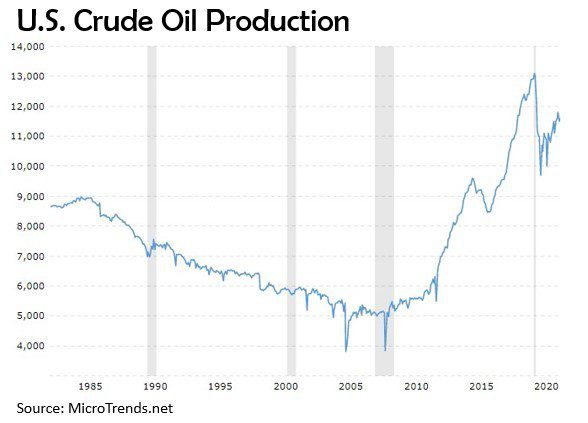Due to the efforts of environmentalists, big banks’ loans for green projects reached parity with oil and gas financing in 2021. In 2018, Wall Street banks loaned four times as much money to fossil fuels as clean energy. By 2021, the ratio was almost one to one.
As a candidate, Joe Biden embraced the goal of “a 100% clean energy economy and net-zero emissions no later than 2050.” Once inaugurated, he moved decisively to implement his plan through actions including:
- Canceling permits for the Keystone XL pipeline to bring an estimated 830,000 barrels of Canadian oil into the U.S. daily,
- Restricting access to oil and gas development in Alaska and Outer Continental Shelf (offshore production),
- Implementing stringent rules on methane emissions from oil and gas production,
- Slowing leasing of federal lands for exploration, and
- Instituting more stringent fuel efficiency regulations and CO2 reductions.
Critics of the policy include Katie Tubb, a policy analyst for the Thomas A. Roe Institute for Economic Policy Studies at The Heritage Foundation.
In a piece for The Signal, Tubb wrote that “the Biden administration and its allies in Congress have made it very clear that they intend to put the oil industry in America out of business.”
America’s crude oil production fell for months under the Biden administration. The Russian invasion of neighboring Ukraine in February disrupted supply lines and reversed the trend of declining U.S. oil and gas production.

In March 2022, Maciej Kolaczkowski, manager of the World Economic Forum’s Energy, Materials, Infrastructure Platform, posited that the Russian-Ukraine war sent the price of oil to extreme levels, and the burden of that price is being passed to consumers at the pump.
“High energy prices contribute to increased cost of virtually all goods and services, further fueling inflation expectations,” said Kolaczkowski.

Before Russia invaded Ukraine, economists were already worried about the level of “energy price pain” associated with a rapid transition to a green economy.
Fossil fuels currently produce nearly 87% of global energy, with wind and solar combined accounting for only 4% of the total. Natural gas, oil, and coal provided almost 80% of the United States’ primary energy production in 2020, with renewable fuels accounting for just 12%.
Oil and natural gas are also feedstocks for plastics and polymers, critical in manufacturing solar panels and wind turbines.
In 2010, plastics and polymer production consumed approximately 191 million barrels of liquid petroleum gases (LPG) and natural gas liquids (NGL), plus 412 billion cubic feet of natural gas. Between 2010 and 2020, plastics production increased from 270 million metric tons to 367 million metric tons.
In his book, Energy: A Beginner’s Guide, Vaclav Smil, distinguished professor emeritus in the Faculty of Environment at the University of Manitoba, wrote that restricting oil and gas production naturally raises prices and creates a political backlash to the high energy costs.
Smil discusses the concept of “infrastructural inertia,” cautioning that this adverse reaction could entrench fossil fuel reliance for decades.
Despite the economic impact of transitioning to a world without fossil fuels, the UN’s Intergovernmental Panel on Climate Change issued a report on April 4, 2022, that the earth is “firmly on track toward an unlivable world.”
Referring to countries’ and companies’ optimism about their environmental programs, UN Secretary-General Antonio Guterres said, “Some government and business leaders are saying one thing but doing another. Simply put, they are lying. And the results will be catastrophic.”
Proponents of the continued production of fossil fuels note that previous evolutions to new energy sources — wood to coal, coal to oil, oil to natural gas — typically take place over decades. Transitions are slow, as infrastructure to produce, move, and consume the old fuel source already exists. They claim a strategy to defund fossil fuels before a transition can reasonably occur is self-defeating and likely to set environmental improvements backward for decades.


